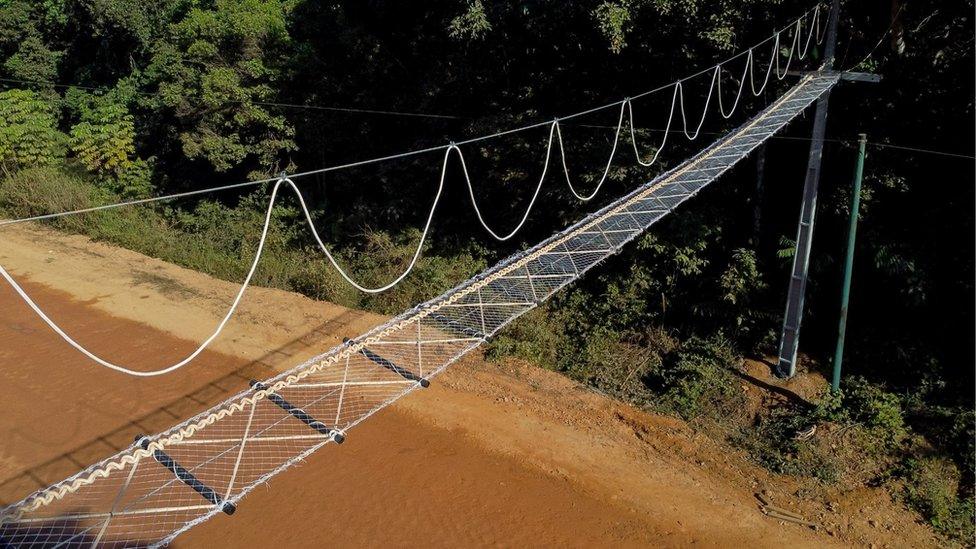Amazon: Monkeys given new safer way to cross the road
- Published
- comments

In the Amazon it's not 'Why did the chicken cross the road?', but rather 'How can the monkeys cross the road?'
This was the issue facing primates in the rainforest in Brazil, so an animal charity has helped to built a "canopy bridge" designed specifically to allow endangered and vulnerable primates to safely cross a highway.
It is the first time a highway in the Brazilian Amazon has had an aerial road overpass for wildlife, and it's hoped it will also be used by other tree-dwelling animals too.
The region is known for its wildlife and plants, and the Wildlife Conservation Society (WCS) helped build the bridge which has been made using new technology that has never been seen before in the country.
It was built at the height of the treetops, to help all arboreal wildlife - animals that feed, move and sleep on trees - but conservationists expect primates will benefit most from the crossing.
In Brazil some 40 percent of all primate species are endangered with the greatest diversity occurring in the Amazon.
The canopy bridge was designed considering movements of big primates like the the woolly monkey and the black-headed spider monkey which have their areas of movement disrupted by the road.
The woolly monkey is considered "vulnerable" to the risk of extinction and the black-headed spider monkey "endangered" according to the Red List of the International Union for Conservation of Nature (IUCN).
Wooly monekys are among those who conservationists think will be most likely to use the new canopy bridge
The bridge crossing opened at the end of July, on an area of road connecting the cities of Manaus and Porto Velho.
The WCS's Conservation Director in Brazil, Marcos Amend, said that although people often think the biggest problem with the highway is that monkeys can be injured of killed when crossing the road, this isn't the only problem.
The widow monkey, black-capped capuchin, howler monkeys, squirrel monkeys, and white-lipped tamarin are also among those likely to benefit, as well as other, tree-dwelling mammals such as opossums, squirrels, coendous, lesser anteaters, kinkajous and, eventually, reptiles such as snakes and lizards.
He said: "One of the major impacts that happen before being run over is the segregation of groups of primates", which means that can not longer live and mate together.
The separation also affect plant-life too, and it's hoped the bridge will be effective in reconnecting populations.
Biologist Fernanda Abra said: "Many species that are more sensitive to habitat change no longer cross from one side to the other, especially arboreal fauna, which need forest connectivity to move around. This is what we call habitat fragmentation.
"Therefore, it is essential that we reconnect these forest fragments."
There are also plans for the existing road, which is made of dirt and dust, to be paved over which would cause even more problems for the creatures living nearby.
Amend said: "It is an area that still has well-preserved forests, but just the prospect of paving the road already generates pressure for occupation and, along with this occupation, comes deforestation, land grabbing."
Exerts say that canopy bridges such as this one are among the most effective strategies to help protect against the direct impacts of highways in the Amazon.
In total there are 30 bridges, and 70 more are planned.
Cameras have been installed in some of those tunnels to monitor the animals, with the information gathered able help guide experts as they think of other and better ways to protect wildlife in the region.
- Published15 January 2023
- Published12 February 2022
- Published2 July 2019
